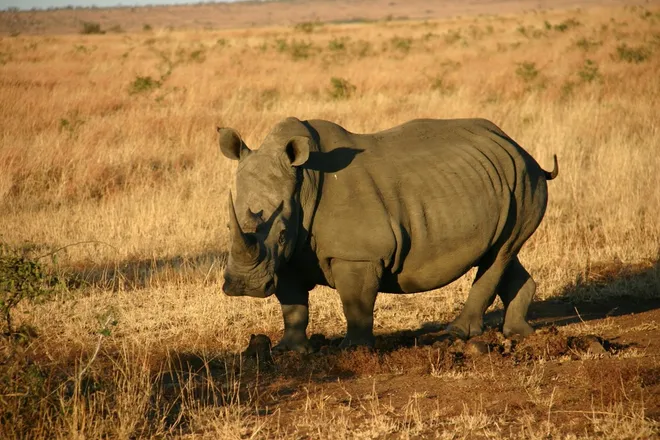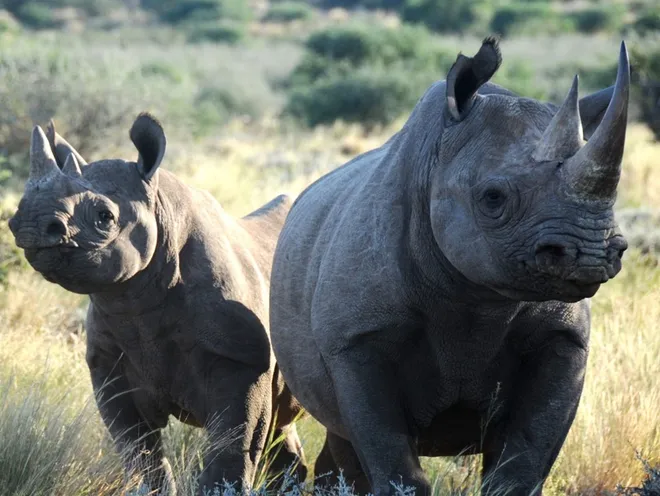Rising temperatures from climate change could threaten rhinos in Africa, researchers say.
Rising temperatures in the southern half of Africa could one day make it too hot for one of the continent’s iconic animals, according to a research team at the University of Massachusetts Amherst.
Increasingly hot temperatures could be "very bad news" for rhinos, and changes in rainfall also could threaten the animals, the researchers said in a study published Wednesday in the journal "Biodiversity."
Despite the dire potential, Africa's national park managers and conservationists can use information about the projected conditions to plan to help the animals adjust to a hotter climate, said Timothy Randhir, a professor of environmental conservation at the university and the paper's senior author.

Temperatures expected to rise
Africa’s average monthly temperatures have risen up to 2 degrees Celsius (3.6 degrees Fahrenheit) over the past century, according to the research, led by graduate student Hlelowenkhosi S. Mamba. Average temperatures could rise by that much and more by the end of the century, the research found. The modeling used projections from the Intergovernmental Panel on Climate Change.
The work focused on five large national parks with diverse landscapes across the southern half of the continent. They looked at temperature variations that could occur by 2055 and 2085 under two greenhouse gas emission scenarios.
Under a moderate scenario, temperatures could be 2.2 degrees Celsius warmer by 2055 and 2.5 C warmer by 2085, they concluded. But, if greenhouse gas emissions aren't reined in, they found each park could warm by as much as 4.6 C by 2085.
Two parks – Etosha National Park, in Namibia, and Hlane National Park, in Eswatini – would become too warm for rhinos in either scenario. Only one park, Tsavo West National Park in Kenya, would see more rainfall in the future, the researchers said.
The higher temperatures could quickly exceed an acceptable threshold for the rhinos, the study concluded. While temperatures would be increasingly unsuitable for both species, the researchers said it's likely white rhinos would be affected earlier.
The probability of either black rhinos or southern white rhinos surviving the heat could shrink to zero by 2085 in locations where the temperatures reach one of the higher scenarios, the researchers found.
But Stuart Pimm, a conservation scientist at Duke University who's not affiliated with the study, expressed optimism the rhinos will survive somewhere for the foreseeable future, given the wide range of conditions in which they can thrive.
"We must be concerned about the impacts of climate disruption," especially for vulnerable species, Pimm said. However, it's very hard to predict how species will respond to climate disruption and rhinos now occur over a wide range of conditions, he said, including some very hot deserts.
What do we know about rhinos in Africa?
Conservation scientists report they've seen rhino numbers begin to increase in Africa, although poaching is still a threat.
Southern white rhinos:
- An estimated 16,800 southern white rhinos remain in the continent, primarily concentrated in five countries, according to the International Union for Conservation of Nature.
- They weigh between 4,000 and 6,000 pounds.
- They stand 5 to 6 feet tall,
Black rhinos:
- Critically endangered.
- Population in Africa estimated at just under 6,500 by the IUCN.
- They weigh between 1,750 - 3,000 pounds
- They stand 4.5 - 5.5 feet high.
Like other iconic large mammals in Africa, IUCN research has shown rhinos are important because they provide habitat for other wildlife species, contribute to the livelihoods and well-being of local people and attract tourists from all over the world, contributing to local economic development.
What can be done to prepare for hotter temperatures?
Most animals will be negatively affected by climate change, Mamba said. But it will be important for conservationists to watch for trends and plan for the future to help minimize the loss of biodiversity among vulnerable species.
National park managers in the region could begin planning now to help manage the future for rhinos and other animals, if they are to be preserved, the researchers said.
“This paper highlights the importance of using climate predictions for both park and rhino management,” Randhir said. “We propose that park managers think now about increasing water supplies, tree cover, watching for stress and planning to allow rhino migration as the world warms.”
Parks in other countries have explored taking steps to protect rhinos from the ravages of climate change. In Nepal, a national park built an artificial soil mound for rhinos and other wildlife to see refuge during extreme rainfall events, according to a study published in the journal Biological Conservation in October.

Disclaimer: The copyright of this article belongs to the original author. Reposting this article is solely for the purpose of information dissemination and does not constitute any investment advice. If there is any infringement, please contact us immediately. We will make corrections or deletions as necessary. Thank you.







